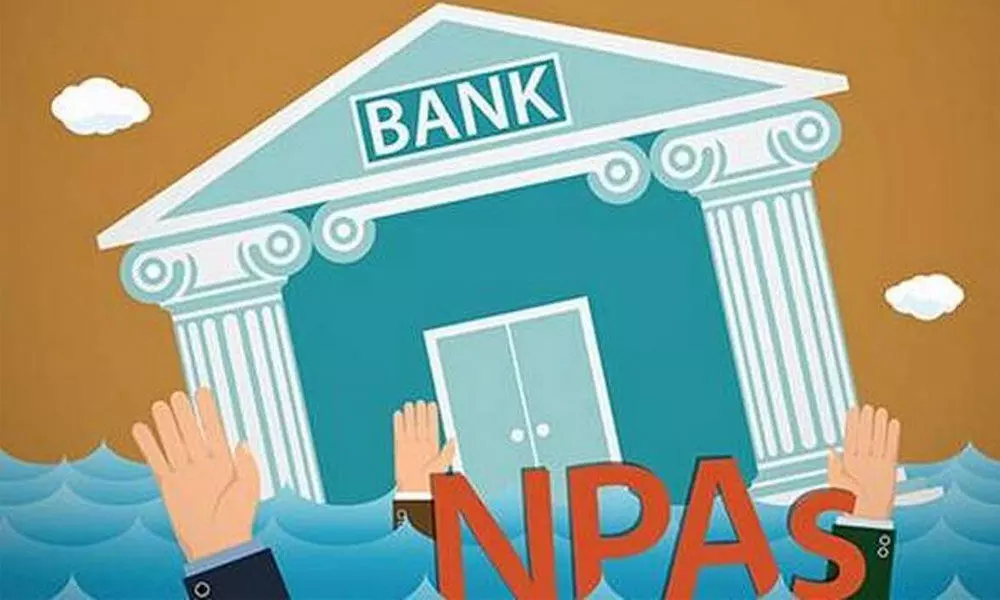Live
- Reckless, Dangerous Arms Race
- Russia needs a peace deal as it is running out of soldiers
- MyVoice: Views of our readers 25th November 2024
- Lack of planning, weak narrative behind MVA debacle
- UTF dist unit golden jubilee celebrations begin
- TSIC launches ‘Innovations 101’ coffee table book
- Drone technology for crime control
- Do you support caste census? Which one will you prefer caste census or skill census?
- DSS to launch gender campaign today
- MJCET holds first-ever 24-hr datathon
Just In

Bank NPAs improve in 2nd half of 2020
Tourism & hospitality, MSME, aviation and restaurants are some of the high NPA risk sectors identified by majority of respondent bankers: Survey
Mumbai: The NPA levels for second half of 2020 have seen an improvement, with 50 per cent of respondent banks reporting a decline in NPAs during current round of survey, which was conducted by FICCI and IBA jointly for the period of July-December, 2020.
Bank wise analysis reveals that major improvement in NPAs has come from the PSBs. About 78 per cent of participating Public sector banks have cited a reduction in NPA levels. This can be attributed to an improvement in asset quality, especially with improved recoveries and higher write-offs by several banks.
Moreover, due to Covid-19 pandemic, the Supreme Court had ordered all banks not to classify Covid-19 related defaults as NPAs. Amongst the sectors that continue to show high level of NPAs, most of the participating bankers identified sectors such as Infrastructure, Metals, iron & steel, Real Estate and Engineering Goods.
However, in terms of outlook, nearly 68 per cent of respondent bankers expect the NPA levels to be above 10 per cent in first half of 2021. Around 37 per cent of respondents in-fact expect NPA levels to be upwards of 12 per cent. In the RBI Financial Stability Report which was released in January 2021, under stress test under baseline scenario, GNPA could go up to 13.5 per cent by September 2021.
Some of the high NPA risk sectors identified by majority of respondent bankers in current round of survey include Tourism and hospitality, MSME, Aviation and Restaurants. Around 55 per cent of respondents believe NPAs to rise substantially in tourism and hospitality sector, while another 45 per cent reported that NPAs are likely to increase moderately in this sector.
Another high NPA risk sector reported in current round of survey is the MSME sector, with 84 per cent respondents expected an increase in NPAs in this sector. Almost 89 per cent respondents also expect Restaurants to see an increase in NPAs, though only 26 per cent expect NPAs to increase substantially in this segment.
Banks were asked to suggest key measures for faster return to normalisation and acceleration of growth thereafter. The recommendations included direct cash transfers to economically weaker sections in rural India, rationalizing personal income tax rates, raising the minimum wages of the low-income workers.
Bankers also suggested increased focus on enhancing indigenous manufacturing capacity, extending PLI scheme to the Manufacturing, Service and Export sectors, reducing the number of GST rate slabs and rationalizing of rates.
Suggestion such as greater spend on infrastructure investments have been allocated in the Union Budget. Amongst the banking related measures, the surveyed respondents had asked for recapitalisation of banks which has also been announced in the Union Budget. Other suggestions included extension of ECLGS scheme till Q1 FY22 and relaxing the NPA classification norms to 180 days.

© 2024 Hyderabad Media House Limited/The Hans India. All rights reserved. Powered by hocalwire.com







